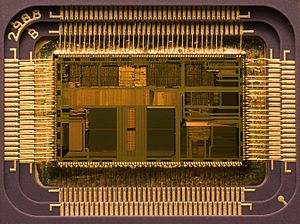Complex instruction set computer facts for kids

A Complex Instruction Set Computer (often called CISC, pronounced "sisk") is a type of CPU design. In a CISC processor, each single instruction can do many things at once. For example, one instruction might load data from memory, do a math calculation, and then save the result back to memory. This is different from a Reduced Instruction Set Computer (RISC), where each instruction does only one simple task.
Over time, the differences between CISC and RISC have become less clear. Modern CISC processors, like the Intel 80486, can still run all the old, complex instructions. However, they work best and fastest on simpler instructions, much like a RISC processor. Newer x86 processors (which are CISC) can even break down complex instructions into smaller, simpler steps called "Micro-operations." These smaller steps can then be processed at the same time, making the computer much faster.
Contents
What is a CPU Instruction?
A CPU (Central Processing Unit) is like the brain of a computer. It follows instructions to do its work. Think of instructions as commands you give to the computer. For example, an instruction might tell the CPU to add two numbers, move data, or make a decision.
How CISC Instructions Work
In a CISC design, one instruction can be very powerful. It can combine several basic operations into a single command. Imagine telling a robot: "Go to the kitchen, pick up the apple, wash it, and bring it to me." That's one complex instruction. This can make programming easier because you need fewer lines of code for some tasks.
Advantages of CISC Design
- Less Code: Because one instruction can do many things, programmers might need to write less code. This can save space in memory.
- Easier for Compilers: Early on, it was thought that CISC designs made it easier for compilers (programs that turn human-readable code into machine code) to work.
Challenges with CISC Design
- Slower Execution: Even though instructions are complex, they can take more time to complete. The CPU might need many internal steps to finish one complex instruction.
- Complex Hardware: Designing and building CISC processors can be very complicated. This is because the CPU needs to understand and execute many different types of complex instructions.
CISC vs. RISC: A Quick Look
The main difference between CISC and RISC is how many steps each instruction performs.
- CISC: Instructions are complex and can do multiple operations.
- RISC: Instructions are simple and usually do only one operation.
Modern CPUs often use ideas from both CISC and RISC. For example, many CISC processors internally convert complex instructions into simpler, RISC-like steps to make them run faster.
Examples of CISC Processors
Many famous computer processors have used the CISC design. Some examples include:
- The IBM System/360
- The VAX family of computers
- The PDP-11
- The Motorola 68000 family (used in early Apple Macintosh computers)
- The Intel x86 architecture, which powers most desktop and laptop computers today.
Related pages
- CPU
- RISC
- ZISC
- VLIW
- Microprocessor
- CPU design
See also
 In Spanish: Complex instruction set computing para niños
In Spanish: Complex instruction set computing para niños

